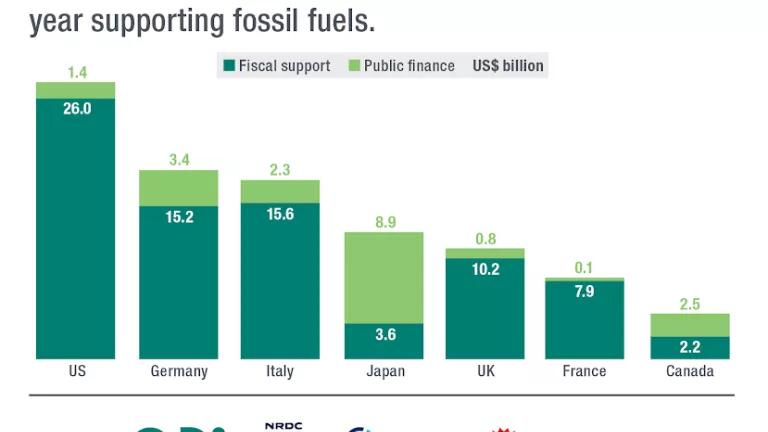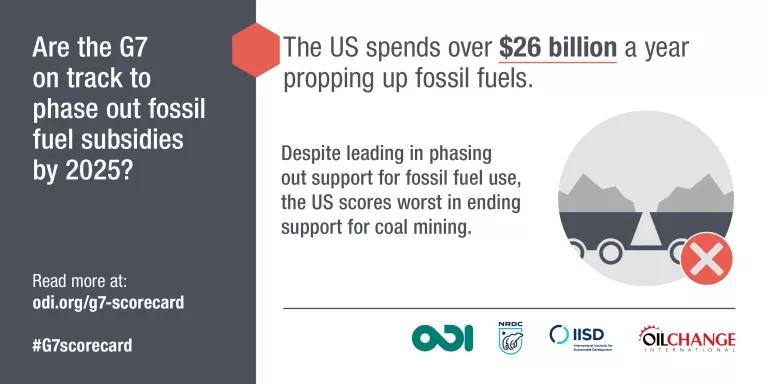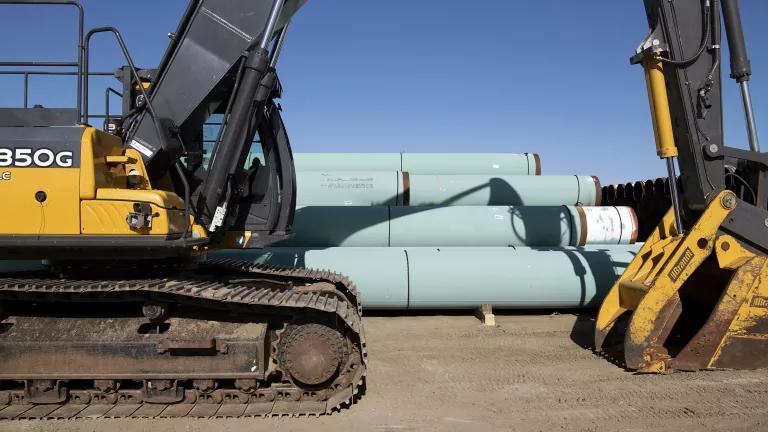
A new study, the G7 Fossil Fuel Subsidy Scorecard, measured the US against other G7 countries on each country’s progress in eliminating fossil fuel subsidies. The US ranked the worst out of the G7 countries, spending over $26 billion a year propping up fossil fuels. (The G7 countries are Canada, France, Germany, Italy, Japan, UK and the US.)
How did the US manage to score so low? By continuing to subsidize fossil fuel production, and then promoting even more pro-polluter, pro-fossil initiatives since President Trump took office.
In 2009, the G7 countries pledged to eliminate fossil fuel subsidies. In 2016, the G7 set a deadline of 2025 for doing so. The G7 Fossil Fuel Subsidy Scorecard, produced by NRDC with the Global Subsidies Initiative, Oil Change International and Overseas Development Institute, tracks progress towards that goal. The indicators to determine progress included assessments of countries’ level of transparency of reporting on subsidies, recent pledges and commitments related to fossil fuels subsidies, and any actual progress ending specific subsidies for fossil fuel exploration, coal mining, oil and gas production, fossil-fuel based power, and fossil fuel use.
While the US ranked higher in some categories such as “transparency” and “ending support for fossil fuel consumption”, it ranked extremely poorly on “pledges and commitments to end subsidies” and on “ending support for coal mining, oil and gas production, and fossil fuel exploration.”
For those who have paid attention to the onslaught of pro-fossil policies from the Trump Administration, the fact that the US ranks last will come as no surprise. (You can find a summary chart of how the US ranks against other countries here). And it’s important to remember that these fossil fuel subsidies come at the expense of public health, local communities, and the climate. Here are some examples of the areas where the US government has continued to prop up fossil fuel companies and how we’ve been fighting back.
Backtracking on fossil fuel pledges and commitments
Following the 2009 pledge by G7 countries to eliminate fossil fuel subsidies, progress has been made, but far too slowly. While other nations have made progress, for example with the UK, Canada, France, and Italy forming part of a global Powering Past Coal Alliance, the US is backtracking on our commitments. Rather than trying to eliminate fossil fuel subsidies and financing, the Trump Administration is promoting more subsidies for fossil fuels at home and abroad.
On the international stage, the Administration rolled back the Guidance to the US Treasury. This Guidance determines whether the US votes to support fossil fuel projects at multilateral institutions such as the World Bank and African Development Bank. The new US policy is to push these multilateral financial institutions to finance more fossil fuel production and consumption in developing countries, a move that’s not only harmful to local communities and health but to global climate goals. The US received a low score on the “Pledges and Commitments” indicator because of these rollbacks of prior policies and for the promotion of new fossil fuel financing. While other countries are moving forward through initiatives such as the Powering Past Coal Alliance, the US has not taken such measures.
Subsidizing domestic coal mining
The US scored the worst out of the G7 countries when it comes to ending support for coal mining. There has been some significant progress in ending government support for coal mining by Canada, France, and Italy, which may be due to the EU Member States’ commitment to phase out subsidies to hard coal mining by 2018. Meanwhile, the US still retains loopholes in how royalty payments are calculated for mining on public lands. Even worse, the Trump Administration has cancelled plans to review and modernize the federal coal leasing program.
The outdated process for determining fair market value for coal has cost taxpayers more than $30 billion over the last 30 years. In one example, companies were paying fees for a sale valued at only $1 when the open market price was anywhere from $10 to over $100 per ton of coal.
And it’s not only for coal. The Interior Department is “short-changing taxpayers and enriching fossil fuel executives” by allowing companies to avoid paying proper royalty rates for oil and gas too. That’s why NRDC filed to intervene in a lawsuit against the Trump Administration to prevent companies from underpaying fees for extracting fossil fuels from publicly-owned lands.
Subsidizing fossil fuel production
The largest amount of US subsidies are for oil and gas production. The total for 2015/2016 was an average of $15 billion a year in fiscal support for oil and gas production. The only country to rank worse was Canada. While the tax bill passed in 2017 repealed two subsidies with current near-zero value to industry, the same bill included new tax provisions that benefit holders of Master Limited Partnerships. Most Master Limited Partnerships are oil and gas interests. Internationally, the promotion of a US-led fossil fuel alliance has drawn sharp criticism.
Research has shown that nearly half of discovered US oil that is not yet developed is dependent on subsidies. For example, in the Williston Basin of North Dakota, 59% of oil resources are subsidy dependent. In the Permian Basin of Texas, 40% of oil resources are subsidy dependent. Even so, the Trump Administration has opened up large swaths of land and our oceans to new drilling, despite the fact that many projects are heavily subsidy-dependent and unnecessary.
Note: Direct comparison of the value of fiscal support between countries can be challenging. As the OECD emphasized in its 2015 Companion to the Inventory of Support Measures for Fossil Fuels, a significant number of subsidies take the form of tax expenditures that are calculated using a country’s benchmark tax regime. Because this can vary widely by country, tax expenditure estimates are not readily comparable across countries (OECD, 2015).
Subsidizing fossil fuel-based power generation
In 2017, the Department of Energy under Secretary Rick Perry attempted to funnel billions of dollars from utility customers to the owners of old and expensive coal plants. He requested that the Federal Energy Regulatory Commission issue an order propping up the failing plants to support the “resilience” of the energy system, despite having no evidence that they were needed, and without even defining “resilience.” Fortunately, the Republican-led Federal Energy Regulatory Commission unanimously rejected the proposal.
Having failed to secure a bailout from the Federal Energy Regulatory Commission, one of the coal plant owners is now lobbying for an emergency order from the Department of Energy to force customers to pay subsidies to coal plants located within the nation’s largest regional grid, PJM Interconnection, to keep them running, despite the grid operator’s analysis that the plants are not needed for reliability purposes. Similar to the argument happening in the UK and elsewhere about “capacity mechanisms,” the argument is that paying these fossil fuel power generators ensures “resilience” based on the supposed security they provide to the grid relative to variable renewables resources, even though such claims are not well-grounded in facts.
Internationally, the US government has also used public funds to support fossil fuel-based power generation. The US Export-Import Bank has supported numerous gas-fired power plant projects in Ghana, Nigeria, Senegal and Spain.
Time for Reform
The first step to eliminate subsidies is to do a full accounting of those that exist. Fortunately, the US ranks relatively well on the transparency of reporting on fossil fuel subsidies, because the US and China completed a subsidy “peer review” process under the auspices of the G20. While the official US report contained gaps compared to the data on subsidies we’ve collected in this report, at least the US review included a list of substantial subsidies in need of reform.
The next step is to actually implement the reforms needed to eliminate subsidies. Much of this will require action through Congress, as many of the subsidies are embedded in the tax code. Rather than spending billions subsidizing fossil fuel companies, it’s time for lawmakers to take proactive steps in the near-term to phase out government support for fossil fuel production at home, with a strong emphasis on ensuring a just transition for workers involved in these industries.



